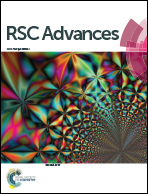Characterization and optimization of graphite felt/BP2000 composite electrode for the H2/Br2 fuel cell
Abstract
A promising graphite felt/BP2000 composite electrode is fabricated and investigated as a cathode for the hydrogen bromine (H2/Br2) fuel cell, which significantly improves the fuel cell performance. The structure, composition, electrochemical properties and performance of the composite electrodes are optimized and characterized using X-ray diffraction, scanning electron microscopy, mercury intrusion, electrochemistry impedance spectroscopy and single cell polarization curves. The effects of binder, Nafion content, catalyst loading and operating temperature are examined. Maximum power densities of 0.91, 1.13 and 1.28 W cm−2 have been achieved at 30, 50 and 70 °C, respectively, with 30% Nafion content and 2.5 mg cm−2 catalyst loading in the composite electrode. The performance improvement may be attributed to the increase in the electrochemical catalytic activity and mass transport of the composite electrode, for the loading of high specific surface area BP2000 catalyst and Nafion binder.


 Please wait while we load your content...
Please wait while we load your content...